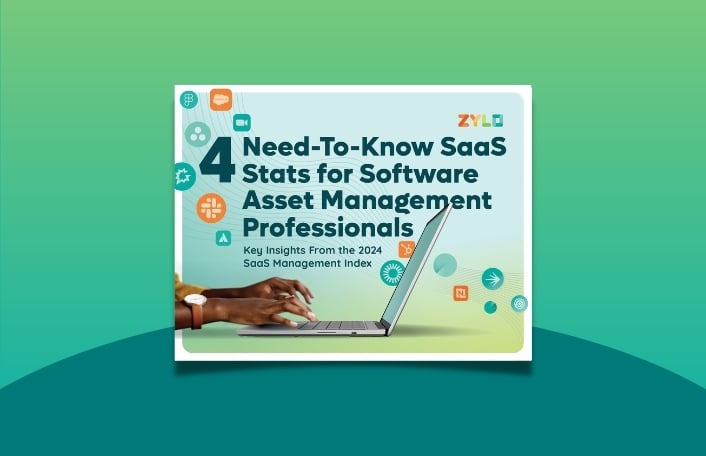
4 Need-to-Know SaaS Stats for Software Asset Management
Don’t Let the Status Quo Hold You Back SaaS is fundamentally...
Back
Back
Search for Keywords...
Blog
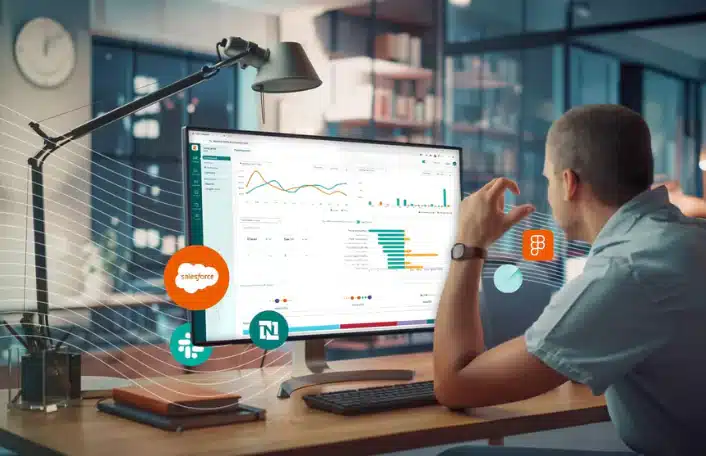
Table of Contents
Between millions of dollars in license waste, unknown security and compliance risks, and overspending, there’s a lot at risk for your business. Often, SAM teams don’t have the right tools to keep up with SaaS Management.
That’s where a SaaS Management platform (SMP) steps in. A platform helps software asset management teams optimize SaaS and be audit ready with comprehensive visibility and control – ultimately reducing license waste, risk to the business, and overspending.
But, selling the idea of a SaaS Management platform across departments can be difficult without executive buy-in. With SaaS Management, it is important to get this support from multiple stakeholders: ideally from your CIO and CFO, but sometimes director or VP level depending on your organization.
At Adobe, support from their CIO has proven instrumental in getting this buy-in and ongoing support of their software management program.
“Success of any company-wide program requires executive support. At Adobe, we report into the office of the CIO. My CIO provided 100% support, which helped us implement a global software optimization program.”
— Ash Rai, Director, Software Asset Management and Vendor Relations
What do you need to include in your business case for a SaaS Management Platform? We’ve outlined three critical elements.
Presenting data points and illustrating the scale of the problem helps you explain why you need a SaaS Management platform. Doing so will not only address these issues but also align with your company’s strategic goals of reducing costs and mitigating risks.
SaaS Is Here to Stay
SaaS now makes up the majority of software deployment. In 2023, IDC reported that SaaS made up 60% of total software spending. This trend is expected to continue, as more software publishers move to the Cloud. In fact, Gartner predicts that by 2025, 60% of the top 20 software and SaaS providers will base their pricing on revenue, employee count, or expected usage. As such, companies must adapt their cost of ownership models and contract negotiation strategies.
You Have More Than You Think
SAM teams often lack control over SaaS spending because SaaS procurement is now widely distributed across business units. That’s why many organizations underestimate their SaaS expenditure by 3X and the size of their software inventory by 1.7X.
Zylo’s SaaS Management Index reveals that the average enterprise operates with 660 applications and spends $284M annually on SaaS, a 7.4% increase from 2023. SaaS is a larger and more enduring problem than you think.
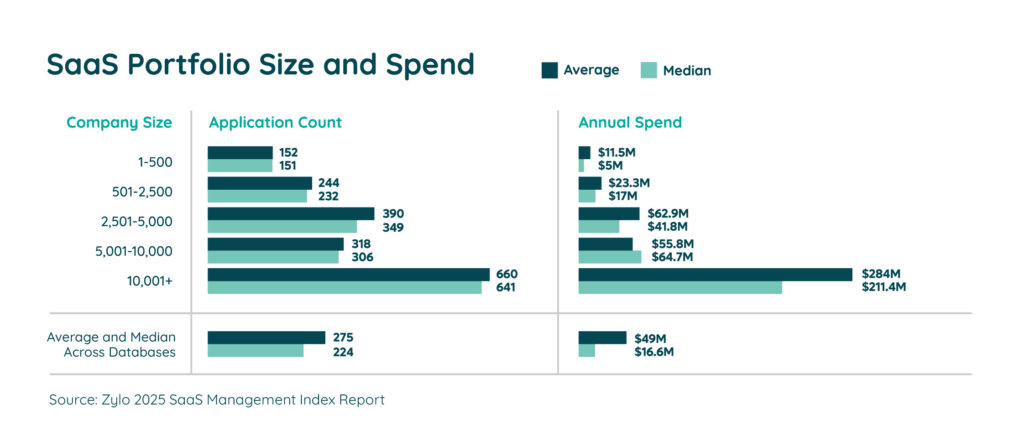
License Waste Is High
According to our research, 55% of SaaS licenses go unused within enterprises on average. That leads to an astounding $127.3M in wasted spending annually. A SaaS Management platform helps reveal this waste and drive substantial cost savings by optimizing license usage.
Unmanaged Risk Is Concerning
As highlighted in the 2024 Gartner® Magic Quadrant™ for SaaS Management Platforms, organizations using unmanaged SaaS are five times more likely to experience a cyber incident or data loss. Furthermore, 68% of expensed applications in enterprises have a “Poor” or “Low” security score, increasing their vulnerability to cyber threats. A SaaS Management platform gives you visibility to mitigate security and compliance risks.
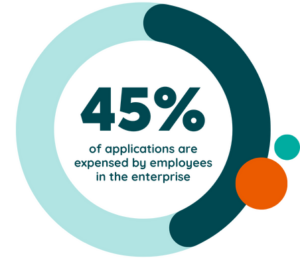 Overspending Runs Rampant
Overspending Runs Rampant
Overspending is prevalent, with organizations typically overspending on SaaS by at least 25%. Shadow IT, where employees purchase applications without centralized oversight, exacerbates this issue. In the enterprise, 45% of applications are expensed by employees, contributing to fragmented and uncontrolled SaaS spending. A SaaS Management platform reveals shadow IT, enabling you to implement governance and monitor your spending.
Implementing a SaaS Management platform can significantly enhance your company’s ability to achieve its strategic objectives, particularly those focused on reducing risk and optimizing costs. Here’s how an SMP aligns with and supports these goals:
Visibility into your entire SaaS inventory is critical. A comprehensive view of your SaaS stack helps you understand what applications are in use, how much you’re spending on them, who is using them and how, and potential risks. This insight is foundational for effective SaaS Management.
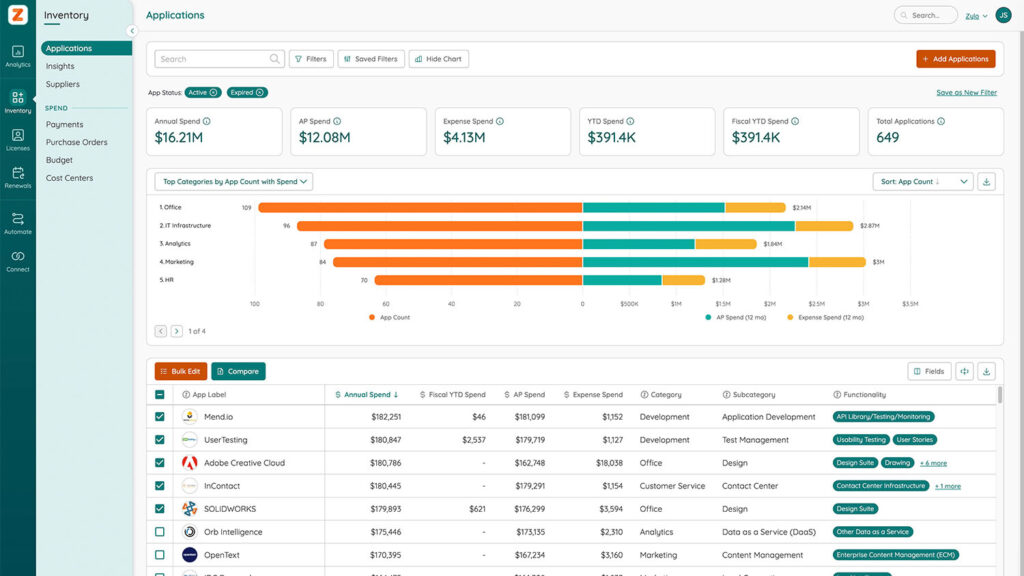
Renewing SaaS contracts can be a complex process. But with a SMP, you can handle renewals efficiently and effectively, ensuring you make the most of your SaaS investments. For instance, Zylo’s platform centralizes all essential information for renewals, ensuring you have everything you need at your fingertips:
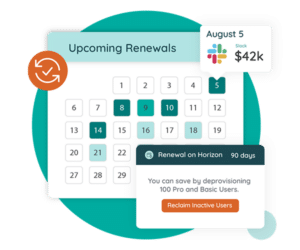 Centralized information: Contracts, terms, owners, and usage data all in one place.
Centralized information: Contracts, terms, owners, and usage data all in one place.Finding and reducing license waste is challenging without visibility. A SaaS Management platform helps you identify unused licenses, prioritize optimization opportunities, and remove waste from your stack.
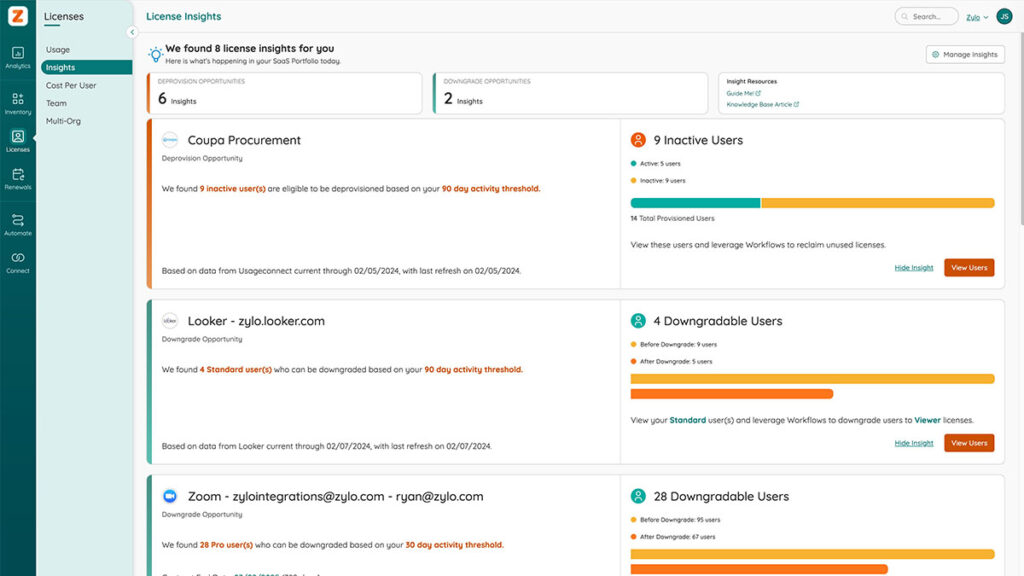
Managing risks associated with SaaS is essential for maintaining enterprise security and compliance. A SaaS Management platform helps you:
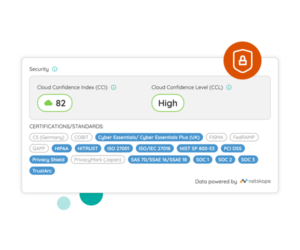 Maintain a current system of record for application ownership to ensure accurate tracking and compliance with licensing agreements.
Maintain a current system of record for application ownership to ensure accurate tracking and compliance with licensing agreements.By mapping these objectives to the outcomes of a SaaS Management platform, you can demonstrate to executives how adopting such a platform supports your company’s strategic goals by driving both cost efficiency and risk reduction.
When proposing the adoption of a SaaS Management platform, you will need to address common questions from executives to build a compelling business case. Here’s how to effectively answer these crucial questions:
The limitations of traditional SAM tools may be holding you back. A SaaS Management platform is necessary because legacy SAM tools and spreadsheets fall short in several critical areas:
“On-premises software tools don’t give you the SaaS Management and SaaS visibility that you need. You can’t run with just one tool in the software asset management space.”
– Jason Owens, Senior Director, Asset Management at Salesforce
In reality, you’re not prioritizing this over other initiatives, as SaaS Management is a critical lever to achieving numerous different strategic initiatives. SaaS Management can drive significant strategic benefits, supported by benchmark data:
Understanding the potential return on investment (ROI) and the time to realize value is crucial for gaining executive buy-in. Based on current benchmarks, optimizing SaaS licenses and reducing waste can result in significant cost savings.
Zylo customers typically see an average 6X return on investment. The improvements in cost savings and compliance can be observed within weeks, instead of months or quarters.
Jason Carney, SVP, CRO, CSO, and Business & IT Asset Management at FIS, noted, “Zylo enabled us to provide value we’ve never been able to before. All of a sudden, we are armed with data to allow the business to make a better decision. Within 6 months of a 2-year project, we are already at over 80% of our savings target.”
By answering these questions clearly, you can build a strong case for a SaaS Management platform, demonstrating its alignment with strategic goals and potential for significant ROI.
Establishing control over your SaaS environment is essential for reducing costs, mitigating risks, and ensuring compliance. Zylo offers a comprehensive solution tailored for Software Asset Managers, providing the tools to manage and optimize your SaaS portfolio effectively.
Want a deeper look at how Zylo can transform your SaaS management practices? See how we can help you bring SaaS under control by exploring Zylo for Software Asset Managers. Or, request a demo to take a deeper dive into how it works.

Don’t Let the Status Quo Hold You Back SaaS is fundamentally...

Table of Contents ToggleMyth #1: SaaS Is in the Cloud, So...

Table of Contents ToggleWhat to Include in Your Business Case#1: Present...

Table of Contents ToggleWhat Are Longtail SaaS Applications?The Rise of Longtail...
| Cookie | Duration | Description |
|---|---|---|
| cookielawinfo-checkbox-analytics | 11 months | This cookie is set by GDPR Cookie Consent plugin. The cookie is used to store the user consent for the cookies in the category "Analytics". |
| cookielawinfo-checkbox-functional | 11 months | The cookie is set by GDPR cookie consent to record the user consent for the cookies in the category "Functional". |
| cookielawinfo-checkbox-necessary | 11 months | This cookie is set by GDPR Cookie Consent plugin. The cookies is used to store the user consent for the cookies in the category "Necessary". |
| cookielawinfo-checkbox-others | 11 months | This cookie is set by GDPR Cookie Consent plugin. The cookie is used to store the user consent for the cookies in the category "Other. |
| cookielawinfo-checkbox-performance | 11 months | This cookie is set by GDPR Cookie Consent plugin. The cookie is used to store the user consent for the cookies in the category "Performance". |
| viewed_cookie_policy | 11 months | The cookie is set by the GDPR Cookie Consent plugin and is used to store whether or not user has consented to the use of cookies. It does not store any personal data. |
